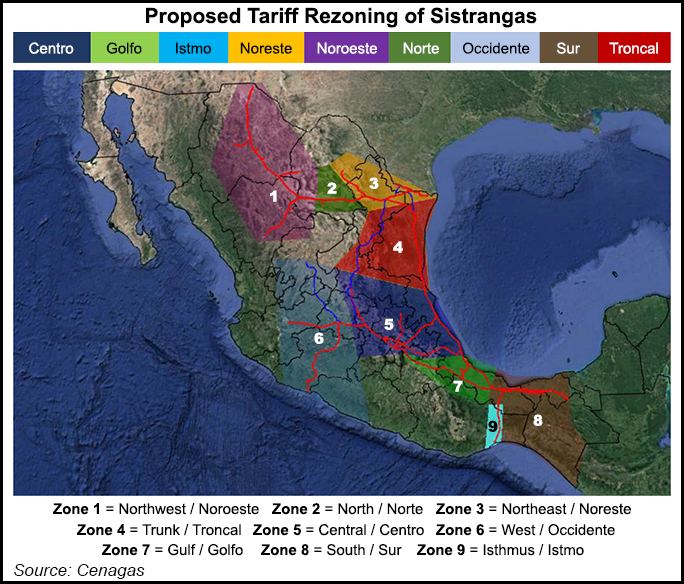Regulatory | NGI All News Access
Mexican Regulator Extends Transport Rates on Sistrangas by One Month
Mexican authorities have renewed the transport rates on Sistrangas, the country’s largest natural gas transmission network, for an additional month to allow its operator to adapt its pipeline management software to a new tariff regime.

The Comision Reguladora de Energia (CRE), Mexico’s energy regulator, last week voted to extend the Sistrangas rates for January-June 2018 to cover July, “in order to avoid creating legal uncertainty for shippers regarding transport services and the associated tariffs,” according to a resolution published at the end of last week.
The system’s operator, the Centro Nacional de Control del Gas Natural (Cenagas), usually updates its tariffs on a six-month cycle — with the second revision originally due to kick in on July 1. However, the rates submitted for 2H2018 also include a complete overhaul of the Sistrangas tariff regime that is still under review by the CRE.
Earlier this year, Cenagas told the regulator that in order to implement the new regime, it would need more time to update the software it uses to manage nominations, confirmations, daily capacity assignments and billing on the pipeline network.
The Sistrangas is currently organized into six tariff zones, each with a postage stamp tariff. The transport rates accrue as gas flows from zone to zone on the system. The Cenagas rezoning proposal, which it submitted in March, would maintain the postage stamp system but redraw the map, reorganizing the pipeline system into nine zones.
The CRE said it would finish reviewing the proposal this month so that Cenagas could implement the new regime and tariffs on Aug. 1. The new rates would cover the remaining five months of the year, expiring Dec. 31.
The reconfigured zones are intended to reflect current commercial and operating conditions on the Sistrangas, whose existing tariff scheme predates the creation of Cenagas and the incorporation of the Los Ramones Norte II pipeline into the system.
The operator has also said it wants to boost its competitiveness along three shipping routes: from the West Texas border to Guadalajara, from the South Texas border to Tuxpan, and from Tuxpan to Guadalajara.
The Sistrangas is comprised of the national pipeline system, directly owned by Cenagas, and six private pipelines. The 6,256-mile integrated network spans 21 of Mexico’s 32 states, including the federal district, and has an operating capacity of 6.13 Bcf/d
Shippers reserved 97% of the system’s capacity during an assignation process in 1H2017. That process included an open season during April, in which 24 companies took 2.23 Bcf/d.
Cenagas earlier this year put the one-year firm transport contracts up for renewal, a process that wrapped up at the end of last month. Shippers on Sistrangas could renew, reduce or completely relinquish capacity, but could not exceed the maximums set forth in the original contracts.
The new transport agreements took effect July 1, although Cenagas has not published the results of the renewal process. The renewed contracts were not capped at one-year, as was the case with the open season in 2017.
Any transport capacity released during the renewals would be offered in an open season later this year, Cenagas officials have said.
The operator also has launched the second edition of its market survey. Implemented for the first time last year, the survey solicits nonbinding expressions of interest from shippers to gauge market demand for transport capacity, natural gas storage and other services.
The 2017 study detected demand for 4.62 Bcf/d of firm transport capacity, 17 MMcf/d of interruptible service and 3.68 Bcf of storage. The new survey is to remain open until Aug. 3. Additional information for interested participants can be found here.
© 2024 Natural Gas Intelligence. All rights reserved.
ISSN © 2577-9877 | ISSN © 2577-9966 |
